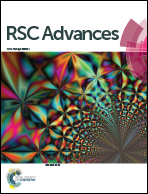First-principles study of the adsorption behaviors of Li atoms and LiF on the CFx (x = 1.0, 0.9, 0.8, 0.5, ∼0.0) surface
Abstract
Based on first principles calculation, the adsorption properties of Li atoms and LiF molecules on the fluorographene (CFx) surface with different F/C ratios (x = 1.0, 0.9, 0.8, 0.5 and ∼0.0) have been studied in the present work. The calculated binding energy of Li and CFx is greater than 2.29 eV under different F/C ratios, indicating that the battery has the potential to maintain a high discharge platform during the whole discharge process. But the adsorption energies of LiF on a CFx layer for different F/C ratios are 0.12–1.04 eV, which means LiF is not easy to desorb from a CFx surface even at room temperature. It will stay on the surface for a long time and affect the subsequent discharge. Current calculations also show the structure of the CFx-skeleton will change greatly during the reaction, when there are many unsaturated carbon atoms on the CFx surface, such as at x = 0.8 and 0.5. Moreover, the discharge voltage is strongly dependent on the discharge site. After discharge, the CFx-skeleton may continue to relax and release a lot of heat energy.



 Please wait while we load your content...
Please wait while we load your content...